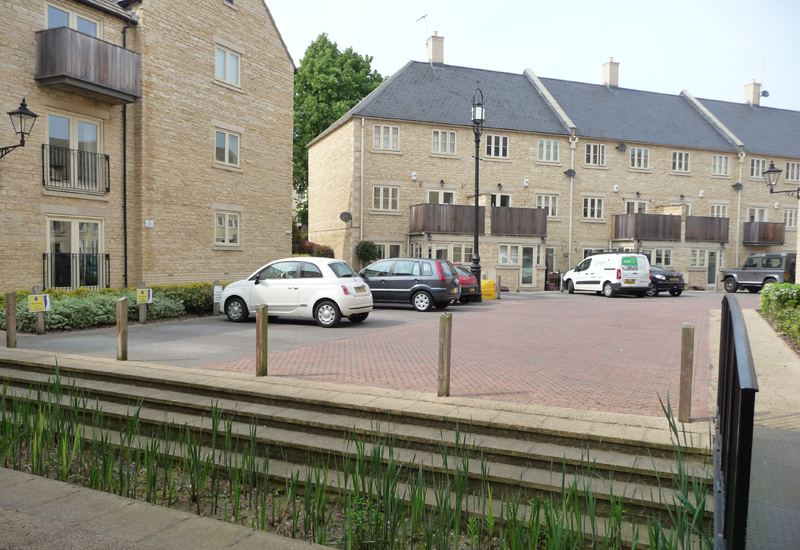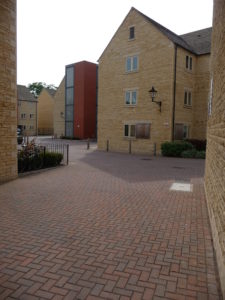
Government planning requirements for SuDS came into force last year for larger new developments. But well designed schemes incorporating concrete block permeable paving – a key SuDS technique – offer developers benefits and opportunities rather than problems, as consultant to Interpave Chris Hodson explains.
 Sustainable drainage systems (SuDS) and techniques such as concrete block permeable paving are essential tools in the fight against flooding and pollution – particularly with overloaded sewers, urbanisation and climate change. Yet Government chose to abandon dedicated plans to implement SuDS on new developments using the 2010 Flood and Water Management Act. Instead, an additional policy now sits alongside the National Planning Policy Framework (NPPF), spelling out “the Government’s expectation … that sustainable drainage systems will be provided in new developments wherever this is appropriate”.
Sustainable drainage systems (SuDS) and techniques such as concrete block permeable paving are essential tools in the fight against flooding and pollution – particularly with overloaded sewers, urbanisation and climate change. Yet Government chose to abandon dedicated plans to implement SuDS on new developments using the 2010 Flood and Water Management Act. Instead, an additional policy now sits alongside the National Planning Policy Framework (NPPF), spelling out “the Government’s expectation … that sustainable drainage systems will be provided in new developments wherever this is appropriate”.
This measure is now being applied by local planning authorities (LPAs) in England through local policies and plans, as well as application decisions on ‘major developments’ of 10 or more dwellings and equivalent non-residential or mixed developments. Government guidance defines SuDS as: “designed to control surface water run off close to where it falls and mimic natural drainage as closely as possible. They provide opportunities to:
- reduce the causes and impacts of flooding;
- remove pollutants from urban run-off at source;
- combine water management with green space with benefits for amenity, recreation and wildlife.”
SuDS Prioritisation
Although the Government measures are much weaker than originally proposed, some LPAs are promoting SuDS and encouraging their wider use through local policies. In addition, existing NPPF prioritisation of SuDS in areas of flood risk and requirements that developments should not make flood risk worse elsewhere – often by utilising SuDS – still apply to developments of any scale.
Under the new arrangements, LPAs must satisfy themselves of minimum  operational standards and ensure that maintenance is provided for the lifetime of the development, using planning conditions or other obligations such as Section 106 agreements.
operational standards and ensure that maintenance is provided for the lifetime of the development, using planning conditions or other obligations such as Section 106 agreements.
According to the Government, SuDS designs should also be ‘economically proportionate’ in terms of initial cost, operation and maintenance. SuDS should eliminate the need for piped drainage and associated components such as gulleys and inspection chambers, as well as heavily engineered water storage structures. Excavation and removal of material from site should also be minimised.
There is plenty of evidence to demonstrate that well-designed SuDS cost no more, and probably less, to install or maintain than conventional piped drainage – particularly when considered as multifunctional elements within the overall project design, as highlighted in the Code of Practice for Surface Water Management BS8582:2013.
No additional land-take
By its very nature, concrete block permeable paving is uniquely placed to help meet multifunctional requirements as an essential SuDS component. Of course, it is needed anyway to provide a hard surface, supporting cars and even HGV traffic loads where needed, also providing a drainage system with no additional land-take. But it also addresses both flooding and pollution issues, unlike storage tanks which only deal with flooding. Constructing permeable pavements on sloping sites is not a problem and it can handle runoff from adjacent impermeable areas of paving and roofs equivalent to double its surface area as well.
Permeable paving can be applied in different systems to allow simple infiltration to the ground or containment and conveyance to another part of the SuDS management train or drainage system – in all cases following attenuation and treatment. It can also be designed to collect, treat and store rainwater for re-use, for example as irrigation, for washing cars or toilet flushing.
Following some 25 years use in the UK and abroad, concrete block permeable paving is a well-established, demonstrably effective technology. Having said that, designers and developers are exploring new opportunities as well. For example retrofit overlay systems of concrete block permeable paving can be used over existing road bases.
Increasingly, designers are considering areas of concrete block permeable paving as distinct storage ‘compartments’. Here, straightforward flow control structures – with access for adjustment – should be applied to the outlets. This technique is useful for containing flows through the pavement construction on sloping sites. It also optimises the time that water remains in the pavement for removal of pollutants. But most importantly, permeable paving compartments provide volume storage deployed around a site which can be demonstrated by flow controls to the LPA as part of the SuDS design approval process.
Of course, permeable paving will help to define the character of a development and its landscape design, adding kerb appeal. The growing choice of concrete block permeable paving products available from Interpave manufacturers – with numerous shapes, styles, finishes and colours – allows real design freedom. At the same time, it can provide completely level, well-drained, firm and slip-resistance surfaces that are accessible to all, without the need for cross-falls, channels, gulleys or other interruptions. Rainwater ‘ponding’ is eliminated, reducing the risk of ice forming on the surface and preventing splashing from standing water.
Real strength
But the real strength of concrete block permeable paving is an ability to remove water-borne pollution offering the important – and often missed – opportunity of a gradual flow of clean water that can be exploited to enhance landscape design and biodiversity. With concrete block permeable paving, SuDS offer developers and designers real opportunities, rather than technical problems to be solved. Taking a holistic approach, designers can now embrace SuDS as one of the central design considerations from the very start of their projects, exploring innovative solutions that form an integral part of urban design.









